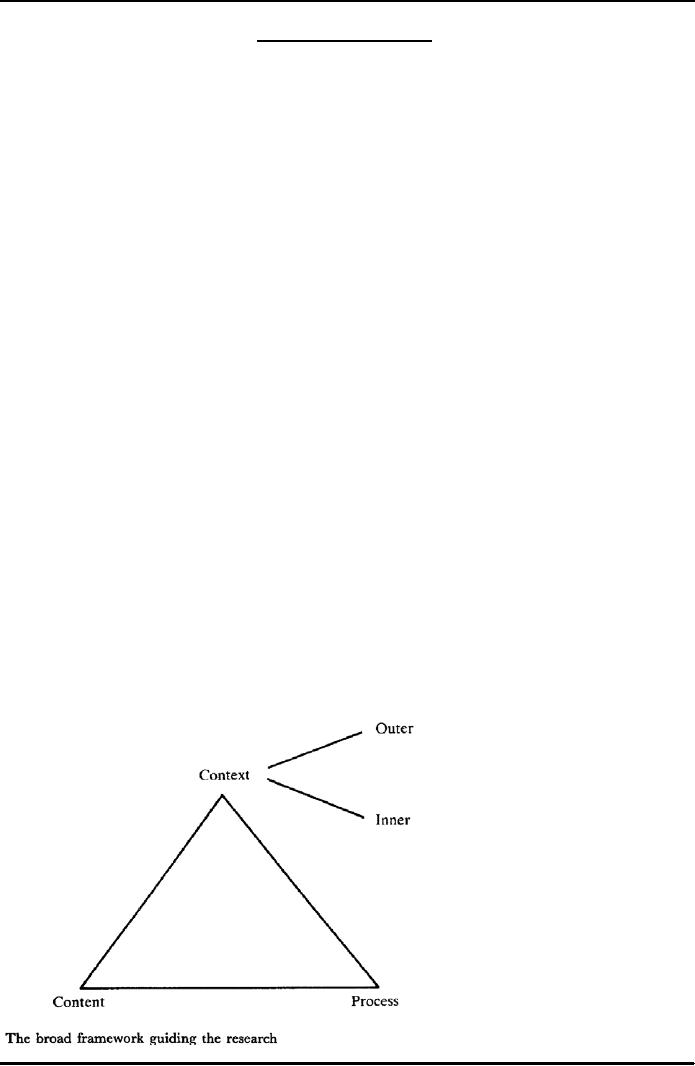 |

Change
Management MGMT625
VU
LESSON
# 29
STRATEGIC
CHANGE
The
concept of change and strategic change
can be interpreted and understood from
different
perspective.
Here I will discuss the
concept will be discussed
from an organizational
transformation
perspective.
One such perspective is given by
Andrew M Pettigrew, one of the
leading management
scholars,
who proposed that change
should not be considered only in
terms of the processes, but
should
also
be considered from the historical,
cultural, and political features of the
organization. His
model
reveals
a continuous interaction between the
context of change, process of
change and content of
change.
He defines context as why and
when of change, and is constituent of
outer context and
inner
context.
The outer context refers to
prevailing economic circumstances whereas
inner context is
concerned
with internal influences
such as resources capabilities,
structure, culture, and
politics.
Content
is defined as what of change, and is
concerned with areas of
transformation. While "process'
is
described
as how of change. This refers to actions
and interactions of the various
stakeholders as they
negotiate
proposal for change. The
model is useful for
understanding complexities of
organizational
change
even for smaller and ordinary level of
change.
Pettigrew
& Whipp's Typology
In
his article, "Context and
action in the organizational
transformation", Pettigrew gave the
partial
review
on the literature for leadership, and
then tried to develop the
linkage between leadership and
organizational
transformation. According to Pettigrew
and Whipp the essential dimensions of
strategic
change
are context, content and
process of change. Let us
deal with them in details
one by one:
1.
Context on X-axis (Why of
change)
There
are some authors like for
instance Berg, Kervasdoue & Kimberly
who consider change as an
ahistorical,
aprocessual and acontextual in character.
This is also because of the
methodological
problems
associated with social sciences in
general and the organization and management
studies in
particular.
Very few studies reveal
that change process is
studied substantially from the
temporal and
contextual
perspective. For example you
might have observed that management
principles we study
are
most
of the time are sweeping generalisations
devoid of context in which
they are evolved. This is
also
important
to see whether change
project is studied as a single
event or as a set of discrete
episodes
separated
from immediate and more
distant antecedents. Such
episodic views give only a
snapshot view
and
fail to provide data on the
mechanisms and processes
through which changes are
created. He
suggested
contextual analysis for
observing the transformational change
meaningfully. See the
figure
below for this.
72

Change
Management MGMT625
VU
The
figure above reveals that strategic
change or major organizational
transformation would
involve
questions
about the content, context and
process of change, and interaction
amongst these broader
categories
of change. The starting
point for this analysis of strategic
change is the notion
that
formulating
the content of any new strategy
inevitably entails managing
its context and process.
Outer
context
refers to the social, political, economic,
business and competitive environment in
which the
firm
operates. Inner context refers to the
structure, corporate culture and political
context within the
firm
through which ideas for
change have to proceed. Thus the firm
may be seeking to change
technology,
manpower, products, geographical
positioning, or indeed corporate culture.
The process of
change
refers to the actions, reactions and interactions from
the various interested parties as they
seek to
move
the firm from its present to
its future state.
According
to Pettigrew the frame of reference
used to guide this research
on strategic change is a
continuation
and development of the author's
(consultant's) previous work on
organizations as political
and
cultural systems. While
Andrews, King and Cleland
believe that here is no
pretence to see strategic
change
as a rational analytical process of
analysing environments, resources , and
gaps, revealing and
assessing
strategic alternatives, and choosing and implementing
carefully analysed and well
thought
through
outcomes. Rather in the manner of Bower
and Mintzberg the transformation of the
firm is seen
as
an iterative, multilevel process,
with outcomes emerging not
merely as a product of rational
or
boundedly
rational debates, but also
shaped by the interest and commitment of
individuals and groups,
the
forces of bureaucratic momentum, gross
changes in the environment, and the
manipulation of the
structural
context around decisions.
Pye
and Pettigrew revealed
important aspects of inner and
outer context in another article
titled,
"Studying
Board Context, Process and
Dynamics: Some Challenges for the
Future". For them
important
aspects
of the outer context include:
the extent of regulation in the
industry in which an organization
is
located;
its ownership structure and investor
relationships with the board; the
presence of other
influential
stakeholders e.g. lobby groups outside the
organization; and the potential for
mergers and
acquisitions
activity.
While
the nature of the industry and business,
besides other important
elements of the inner
context
include
the: commercial requirement of the
organization to develop new
core competencies or strategic
direction;
level of perceived trust in the board, as
viewed by insiders and outsiders; life
cycle of the
company
and of the board and its
culture/ stage of board
development.
The
inner context can further be
classified into two
variables: tangibles and intangibles.
The tangibles
are
structure and resources of organization
while organization culture
and organization
politics.
Intangibles
govern tangibles. In the words of
technology it is the software
(organization culture
and
politics)
which governs hardware (structure &
resources)
2.
Content on Y - axis (What of
change)
The
content of strategic change is dependent upon
managing its context and
process. The process
skills
at
the most general level
involve the legitimation of the content of strategy in
the evolving inner and
outer
context of the firm. The content of
change refers to the particular areas of
transformation under
examination.
Thus the firm may be seeking to change
technology, manpower, products,
geographical
positioning
or indeed corporate culture. The
process of change refers to the actions, reactions,
and
interactions
from the various interested parties as
they seek to move from
its present state to
future
state.
This may include change in
the following aspects of
organization:
-
Assessment and choice of products and
market
-
Objectives and assumptions
-
Fixation of targets and evaluation
criteria
73

Change
Management MGMT625
VU
3.
Process on Z-axis (How of
change)
Two
points are essential to understand the
process aspect of change.
The first is that
structures, cultures
and
strategies are not just
being treated as neutral, functional
constructs connectable to some
system
need
such efficiency and
adaptability; those constructs
are viewed as as capable of serving to
protect
the
interests of dominant group.
Second the biases existing in
structures and cultures can
protect
dominant
groups by reducing the chances of
challenge, and features of inner and
outer context can be
mobilized
by dominant or aspiring groups to
legitimate the existing order, or
indeed to help create
a
new
order. These points are as
pertinent to understanding processes of
strategic change as they are
to
achieving
practical outcomes in strategic
change.
The
political and cultural view of
processes gives a central place to the
processes and mechanisms
through
which strategic changes are
legitimated or delegitimated. The content
of strategic change is
thus
ultimately a product of legitimation
process shaped by political/cultural
considerations, though
often
expressed in rational/ analytical
terms. This recognition that
transformation in the firm
may
involve
a challenge for the dominant
ideology, cultures, systems of meaning
and power relationships in
the
organization makes it clear why
and how the processes of
sensing, justifying, creating,
and
stabilizing
major change can be so
tortuous and long.
We
can also talk of various
formal and informal on-going
organizational processes like
communication,
decision
making, objective setting and
controlling etc. The process
in organization in turn depends
upon
the
followings:
-
Change
managers
-
Models
of change
-
Formulation/
implementation process
-
Pattern
through time
The
three are interdependent with
each other for
instance context and process
define the content of
change.
The structures, cultures and
strategies are not treated as
neutral and functional constructs
high
on
efficiency and adaptability. In overall
analysis the strategic change should not
be considered as a
rational
analytical process of analysing
environments and resource allocations
etc.
References
Pettigrew
Andrew M., Context and
Transformation of the Firm, Journal of
Management Studies Vol.24
No.6
November (1987)
Pye,
Annie and Andrew Pettigrew,
Studying Board Context,
Process and Dynamics: Some
Challenges
for
the Future, British Journal of
Management, Vol. 16,
S27S38, 2005
74
Table of Contents:
- COURSE ORIENTATION:Course objectives, Reading material, Scope of the subject
- BENEFITS AND SIGNIFICANCE OF CHANGE MANAGEMENT:Traditional management domain
- KURT LEWIN MODEL: ASSUMPTIONS AND IMPLICATIONS:Change Movement, Refreeze
- IMPLICATIONS OF KURT LEWIN MODEL:Sequence of event also matters, A Critical Look
- SOME BASIC CONCEPTS AND DEFINITIONS:Strategic change, Logical incrementalism
- TRANSACTIONAL VS. TRANSFORMATIONAL LEADERSHIP:Micro-changes, Organisation Development
- THEORIES OF CHANGE IN ORGANISATIONS
- LIFE CYCLE THEORY:Unit of Change, Mode of change, Organisation death
- TELEOLOGICAL THEORIES OF CHANGE:Unit of change, Mode of Change, Limitations
- DIALECTICAL THEORIES OF CHANGE:Unit of Change, Strategic planning
- A DIALECTICAL APPROACH TO ORGANISATIONAL STRATEGY AND PLANNING:
- LIMITATION OF DIALECTICS; DA AND DI:Overview of application of dialectics
- THEORIES OF CHANGE IN ORGANISATIONS
- APPLICATION OF EVOLUTIONARY THEORY:Managerial focus
- FURTHER APPLICATION OF EVOLUTIONARY THEORIES:Criticism
- GREINER’S MODEL OF ORGANISATIONAL– EVOLUTION AND REVOLUTION
- GROWTH RATE OF THE INDUSTRY:CREATIVITY, DIRECTION, DELEGATION
- COORDINATION:COLLABORATION, The Crisis
- ORGANISATION ECOLOGY:Structural Inertia, Internal Structural Arrangements, External Factors
- CLASSIFICATION OF ORGANIZATIONAL SPECIES:Extent of Environmental Selection, Determinants of Vital Rates,
- FOOTNOTES TO ORGANISATIONAL CHANGE:Stable Processes of Change, Rule Following, Conflict
- SOME COMPLEXITIES OF CHANGE:Superstitious Learning, Solution Driven Problems
- ORGANIZATIONAL ADAPTATION:The Entrepreneurial problem, The Administrative Problem
- PROSPECTORS:Analyzer, Reactors, Adaptation and Strategic Management
- SKELETAL MODEL OF ADAPTATION:Determinants of Adaptive ability, The Process of Adaptation
- STRATEGIC CHANGE:Nature of Change, The Importance of Context, Force field Analysis
- Management Styles and Roles:Change Agent Roles, Levers for managing strategic Change
- SYMBOLIC PROCESSES:Political Processes, COMMUNICATING CHANGE, Change Tactics
- STRATEGIC CHANGE:Pettigrew & Whipp’s Typology, Context on X-axis (Why of change)
- STRATEGIC CHANGE:Attributes of SOC Model, Implications for Management
- STRATEGIC CHANGE:Flow of Information, Recruitment, SOC Process
- Determinants of a Successful Change Management:Environmental, Management Orientation, Management Orientation
- Higgins 08 S Model – An Adaptation from Waterman’s Seven S model:Strategy, Systems and Processes, Resources
- IMPLEMENTATION AND STRATEGIC CHANGE: CONSTRAINING FORCES IN THE IMPLEMENTATION OF STRATEGIC CHANGE (CASE STUDY OF XYZ COMPANY)
- IMPLEMENTATION AND STRATEGIC CHANGE: CONSTRAINING FORCES IN THE IMPLEMENTATION OF STRATEGIC CHANGE (CASE STUDY OF XYZ COMPANY)
- WHY IMPLEMENTING STRATEGIC CHANGE IS SO DIFFICULT?:Change Typology, Technical Change
- IMPLEMENTATION APPROACHES:Attributes of incremental change,
- IMPLEMENTATION: RADICAL OR TRANSFORMATIVE CHANGE
- IMPLEMENTATION: RADICAL OR TRANSFORMATIVE CHANGE:Definition of Leadership, Follower Work Facilitation
- IMPLEMENTATION: RADICAL OR TRANSFORMATIVE CHANGE:Recognize the challenge
- IMPLEMENTATION: RADICAL OR TRANSFORMATIVE CHANGE
- IMPLEMENTATION: PUNCTUATED EQUILIBRIUM MODEL:Features of Radical Change, Theory of P-E model
- CHANGE IMPLEMENTATION: OD MODELS:The Transactional Factors
- CULTURE, VALUES AND ORGANIZATIONAL CHANGE:Significance and Role of Values, Values Compete
- ORGANIZATIONAL VALUES, CULTURE AND ORGANIZATIONAL CHANGE:Issues in Change Management